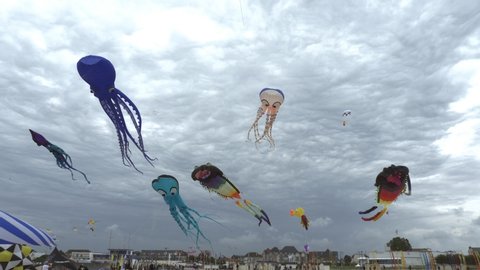Kites Dancing in Clear and Boundless Sky
Kites
The kite is a folk gadget first invented by Chinese. Flying a kite can not only exercise the bodies, but also cultivate people’s sentiment. It is one of the customs popular in the Han nationality.
Introduction of Kites
History
Pitch into a skeleton with the thin bamboo straps, paste over it with the paper painted with various patterns, and finally tie it up with a string. The kite can fly high into the sky relying on the wind-force. The kite boasts a long history. It is said that in the Spring and Autumn Period, Gong Shuban made a wooden kite to peep in the city of the Song Kingdom. After the paper is invented, the kite started to be pasted with paper. When in the Five Dynasties, Li Ye installed a bamboo flute at the head of the kite, which could make a sound similar to that of Zheng (a kind of traditional Chinese musical instrument), so later it gains the name “kite” (Zheng in the Wind).
Combination of Technique and Art
The kite is a perfect combination of technique and art. In the Warring States time, it already spreads widely. When in the Tang and Song dynasties it starts to popularize in both cities and countryside. It reaches its period of full bloom in the Ming and Qing dynasties. Every time the spring breeze is genial and the myriad things thrive, adults and children all “take advantage of the east wind and fly their kites. ” Regardless of the city square or countryside, the seashore or the ravine, the kites dance in the clear and boundless sky. The modelling of the kites is vivid, some like flying dragons and dancing phoenixes, some like the colorful butterfly fluttering about, some like the sporting dragonfly, some like the hawk spreading its wings, some like the Monkey King playing his golden cudge, some like the fairy descending to the earth… The large one can be more than 40 meter long while the small one is only a foot long. The people’s mind already flies into the infinite vault along with those kites, which bring them happiness and dreams.
Not only in spring, people also fly the kite in summer, autumn, and winter. They even fly the kite at night, when people would hang up strings of small lanterns on the kite, which rise into the sky and look like innumerable sparkling stars. Gao Pian, a poet of the Tang Dynasty, writes down the Kite Poem, recording the sentiment of flying the kite at night.

Enjoyable Games of Kites
Playing the kite is not only the children’s game, but also the adult’s entertainment. Not only the common people like playing it, but also the emperors, officials and nobles enjoy the game. Emperor Huizong in the Song Dynasty specially compiled the book of Xuanhe Kite, which had handed down to the later generations, simply because he loved playing the kite. The poem “Tens of thousands of people will go out to have a look when the kite is played” has left behind a record of the grand occasion of flying the kite in the Qing Dynasty. Cao Xueqin is not only a great writer, but also a world outstanding kite player and maker. In one of his books, Cao makes a detailed introduction of the making skills and craft of 43 kinds of kites. The book is also illustrated with charts and attached with 16 verses to facilitate the makeing process.











